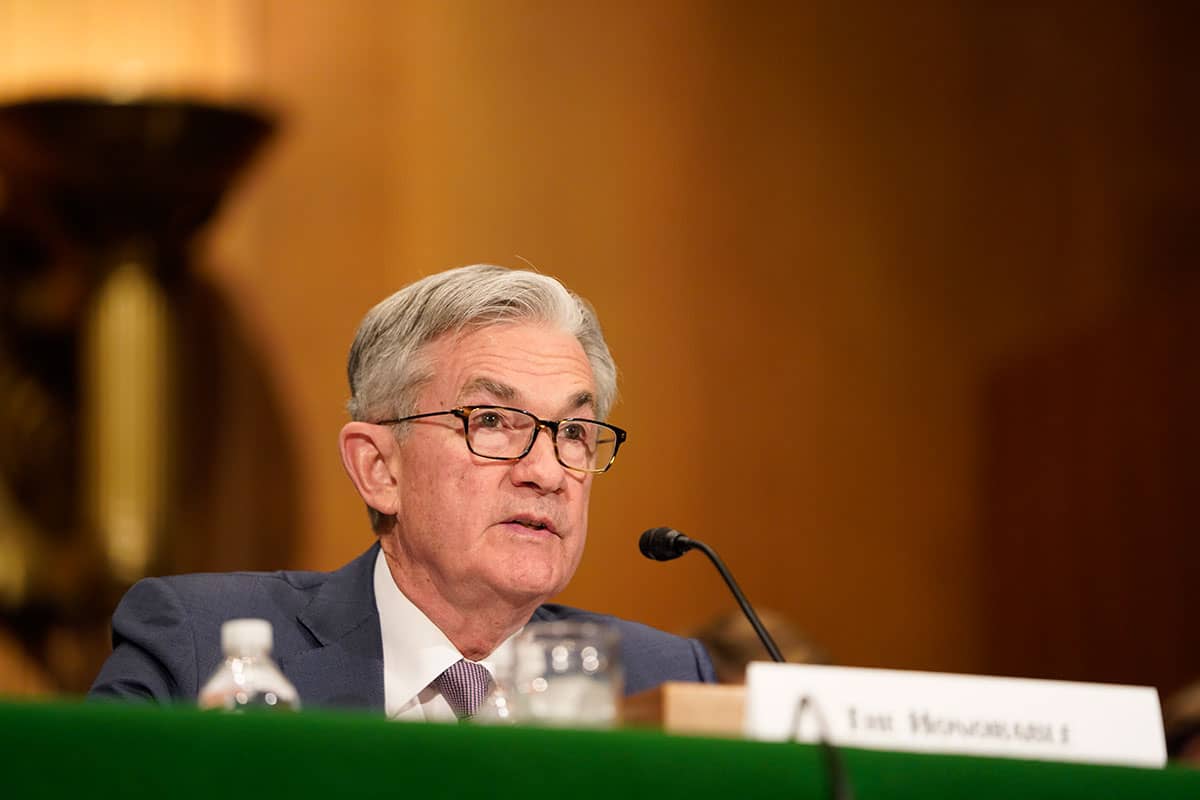Pound-to-Dollar Rate: Fed Ahead

Above: Federal Reserve Chairman Jerome Powell. Image © Federal Reserve.
- GBP/USD spot rate at time of writing: 1.3919
- Bank transfer rate (indicative guide): 1.3530-1.3629
- FX specialist providers (indicative guide): 1.3757-1.3822
- More information on FX specialist rates here
- Set an exchange rate alert, here
The Federal Reserve's March policy event is front and centre for foreign exchange markets today and could well determine how the Dollar trades against the Pound and Euro over coming days.
Ahead of the event, due to start at 18:00 GMT, the Pound-to-Dollar exchange rate (GBP/USD) has stabilised in the middle of a sideways trending range that has been in place during March.
The top of the March range is at 1.40 and the bottom at 1.3780, the pair is at 1.3920 at the time of writing.
The settling of the exchange rate suggests the market is waiting for its next significant directional signal, and between the Fed on Wednesday and the Bank of England on Thursday this signal could well emanate from a central bank.
Fed Chairman Jerome Powell and his team will likely address the big question investors are grappling with at present: that of rising yields on government bonds.
"The FOMC is facing the first big test of its ultra-dovish policy stance," says Valentin Marinov, Head of G10 FX Strategy at Crédit Agricole. "Expectations of a vigorous U.S. economic recovery and even overheating have propelled UST yields to multi-month highs while US rates markets have started front-loading rate hikes.
Treasury bond yields (USTs) have risen sharply thanks to the passage of the $1.9TRN stimulus package, a reflection that investors believe the injection of cash will raise inflation rates over coming months and years. Bond investors demand greater compensation for holding Treasuries if they expect higher inflation in the future, which is in turn reflected in the higher yield the bond issuer pays out.
The side effects of rising bond yields is a generalised rising cost of finance which rips right through the financial sector, which in turn acts as a headwind to the economic recovery.
Another side effect of rising bond yields has been a firmer Dollar. Therefore, the Fed's ability to contain rising yields has implications for the Dollar and markets in general.
If the Fed signals it is comfortable that the rising yields represent improved confidence in the economic outlook, the Dollar could be the big winner in the wake of the Fed meeting.
The rise in yields and inflation exceptions corresponded with the market now pricing in an initial interest rate hike from the Fed within the next two years, with three hikes in total expected by the end of 2023.
Given the more robust outlook ahead, Deutsche Bank's U.S. economists expect that one hike should be reflected in the committee’s updated projections out to end-2023 (via the dot plot chart).
"The dot plot back in December suggested flat rates through 2023. The better economic prospects might have led to some Fed members pushing forward their rate hike expectations. While they will probably still represent the minority view, such a move is likely to be picked up by markets," says Mathias Van der Jeugt, an analyst with KBC Markets.
Goldman Sachs economists tell clients they expect 11 participants to show at least one hike in 2023 versus 7 showing no hikes. Of those showing at least one hike, they expect most to show just one, but a handful to show two or more.
If they are correct, the market faces a decidedly 'hawkish' tilt to today's meeting, which would on balance be supportive of the Dollar.
Higher growth and lower unemployment forecasts are likely to be issued, as well as a modestly higher inflation forecast profile.
"All eyes are on the Fed today. Growth and inflation forecasts will likely have been upwardly revised because of the recently approved fiscal stimulus plan," says Van der Jeugt.
Economist Jim Reid at Deutsche Bank points out inflation expectations have reached fresh multi-year highs in the run up to the Fed event.
Reid says the moves are evident across the curve, with both 2-year and 5-year U.S. breakevens at their highest levels since 2008 on Tuesday, at 2.744% and 2.652% respectively, while 10-year breakevens were up +2.93bps to 2.304%, which hasn’t been seen since 2013.
This is sign that markets are increasingly pricing in a potential shift to a higher-inflation regime beyond just the next year or two, according to Reid.
"The Fed’s view on higher interest rates up until now has been that it represents economic optimism. Striking a similar tone would spur another yield rally," says Van der Jeugt. "Higher yields should in any case support the dollar."
Van der Jeugy says EUR/USD might test 1.1836 support (current 2021 low) in response to the Fed event.
{wbamp-hide start}
GBP/USD Forecasts Q2 2023Period: Q2 2023 Onwards |
"A clear and sustained break means a return to the sideways 1.16/1.20 trading range. Moves in EUR/USD might have knock-on effects on EUR/GBP as well and push the pair to 0.854 support in the run-up to the Bank of England meeting tomorrow," he adds.
EUR/GBP at 0.8540 gives GBP/EUR at 1.1700.
"The Fed will leave policy parameters unchanged, will raise its growth forecasts, and step up inflation expectations, while probably reasserting that conditions are not yet in place to work on the timeline and technicalities of starting the monetary policy normalisation process. This could result in a hiatus in the current uptrend of the dollar, but should not strip it of support, nor undermine the positive underlying trend," says Asmara Jamaleh, Economist at Intesa Sanpaolo.
For the Pound-Dollar exchange rate, Jamaleh says focus will turn back to the dynamic of yields and the outcome of the Fed event is expected to prove "supportive for the dollar against Sterling".
"A more dovish-than-expected outcome from the Fed meeting can boost risk sentiment and weigh on the USD vs risk-correlated and commodity currencies," says Marinov.













